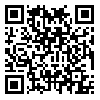1. Chang, P. L. M. H. Chieng. Building consumer-brand relationship: A cross‐cultural experiential view. Psychology and Marketing. 2006, 23 (11). Pp: 927-959. [
DOI:10.1002/mar.20140]
2. Sweeny, J. Swait, J. The Effects of Brand Credibility on Customer Loyalty. Journal of Retailing and Consumer Services. 2008, 15(8). Pp: 179-193. [
DOI:10.1016/j.jretconser.2007.04.001]
3. Bloemer, J. Ruyter,K. Peeters, P. Investigating Drivers of Bank Loyalty: the Complex Relationship Between Image, Service Quality and Satisfaction. International Journal of Bank Marketing. MCB University Press. 1998, 16/7. Pp: 276-286. [
DOI:10.1108/02652329810245984]
4. Torres-Moraga, E. Vasquez-Parragu, A. Z. Zamora-Gonzales, J. Customer satisfaction and loyalty: Start with the product, culminate with the brand. Journal of Consumer Marketing. 2008, 25 (5). Pp:302-313. [
DOI:10.1108/07363760810890534]
5. Taylor, S. A.,Celuch, K. Goodwin, S. The importance of brand equity to customer loyalty. Journal of Product and Brand Management. 2004, 13 (4). Pp: 217-227. [
DOI:10.1108/10610420410546934]
6. Erdem, T. Swait, J. Brand credibility, brand consideration and choice. Journal of Consumer Research. 31(3). 2004, Pp: 191-198. [
DOI:10.1086/383434]
7. Hsiao, C.R. Yeh, G. Y.Y. Wu, P. C.S. The effect of store image and service quality on brand image and purchase intention for private label brands. Australasian Marketing Journal. 2011,19 (1). Pp: 30-39. [
DOI:10.1016/j.ausmj.2010.11.001]
8. Kaul, S. Sahay, A. Koshy, A. Impact of initial - trust - image on shopper trust and patronage intentions. International Journal of Retail & Distribution Management. 2010, 38(4). Pp: 275-296. [
DOI:10.1108/09590551011032090]
9. Zolfagharian, M.A. Paswan, A. Perceived service innovativeness, consumer trait innovativeness and patronage intention. Journal of Retailing and Consumer Services. 2009, 16 (2). Pp: 155-162. [
DOI:10.1016/j.jretconser.2008.11.007]
10. Robledo, M. Measuring and managing service quality: integrating customer expectations, Managing Service Quality, 2001, (11). Pp: 21-31. [
DOI:10.1108/09604520110379472]
11. Yi, Y. La, S. What influences the relationship between customer satisfactions and repurchase intention? Investigating the effects of adjusted expectations and customer loyalty. Psychology and Marketing. 2004, 21(5). Pp: 351-373. [
DOI:10.1002/mar.20009]
12. Wei-Tsong, W. Yi-Shun, W. En-Ru, L. The stickiness intention of group-buying websites: The integration of the commitment-trust theory and e-commerce success mode. Information & Management. 2016, 53(1). Pp: 1-144. [
DOI:10.1016/j.im.2016.01.006]
13. Shalom, L. Hayiel, H. Emotional brand attachment: a factor in customer-bank relationships. International Journal of Bank Marketing. 2016, 34(2). Pp:136-150. [
DOI:10.1108/IJBM-06-2015-0092]
14. Chang, K. H. A study on the relationship between customer relation and behavior intention of fitness clubs-in Taichung city. Master Dissertation, Zhanghua, Taiwan: Dayeh University. 2004, p: 67
15. Liu, Y-Ch. an Analysis Service Quality, Customer Satisfaction and Customer Loyalty of Commercial Swim Clubs in Taiwan. A Dissertation Project Submitted to the Faculty of the United States Sports Academy in Partial Fulfillment of the Requirements for the degree of Doctor of Sports Management. 2008.
16. Ting-Jui, C. En-Chung, C. Yanan, Z. Xiaofei, T. What makes consumers believe: the impacts of priming and sequential service experiences on consumer emotions and willingness to pay. Journal of Services Marketing. 2016. 30(1). Pp:115 - 127. [
DOI:10.1108/JSM-02-2014-0077]
17. Camille, S. Renaud, L. How guilt affects consumption intention: the role of rumination, emotional support and shame. Journal of Consumer Marketing. 2016, 33(1). Pp: 41 - 51. [
DOI:10.1108/JCM-12-2014-1265]
18. Lujun, S. Scott, R. Swansonb, Xiaohong, Chen. The effects of perceived service quality on repurchase intentions and subjective well-being of Chinese tourists: The mediating role of relationship quality. Tourism Management. 2016, 52. pp: 82-95. [
DOI:10.1016/j.tourman.2015.06.012]
19. Anil, B. Melih, M. Peter, R. Service attributes as drivers of behavioral loyalty in casinos: The mediating effect of attitudinal loyalty. Journal of Retailing and Consumer Services. 2016, 31. Pp: 14-21. [
DOI:10.1016/j.jretconser.2016.03.001]
20. Ibrahim, E. Gomaa, A. E-retailing ethics and its impact on customer satisfaction and repurchase intention: A cultural and commitment-trust theory perspective. Internet Research. 2016, 26 (1). Pp: 288 - 310. [
DOI:10.1108/IntR-10-2014-0244]
21. Chethana, Achar1. Jane, S. Nidhi, A. Adam, D. What we feel and why we buy: the influence of emotions on consumer decision-making. Current Opinion in Psychology. 2016, 10. pp: 166-170. [
DOI:10.1016/j.copsyc.2016.01.009]
22. Saatchian V, Safari H R, Rasooli S M, Eskandari E, Elahi A. The relationship of service quality, customer satisfaction and loyalty with future intention for participation of fitness centers (Case study Rasht Township). JRSM. 2013; 3 (5) :125-137.
23. Javadin, SR. Shams, R. Factors determining the specific value of a sports shoe brand. Journal if executive management, 2007; 7(25), 73-96.
24. Keller,K. L. Strategic Brand Management. Building, Measuring, and Managing Brand Equity. 3 Ed., New Jersey. Pearson Education International. 2008.
25. Sweeny, J. Swait, J. The Effects of Brand Credibility on Customer Loyalty". Journal of Retailing and Consumer Services. 2008, 15(8). Pp:179-193. [
DOI:10.1016/j.jretconser.2007.04.001]
26. Bloemer,J. Ruyter,K.& Peeters ,P. Investigating Drivers of Bank Loyalty : the Complex Relationship Between Image, Service Quality and Satisfaction. International Journal of Bank Marketing. MCB University Press. 1998, 16(7) . pp: 276-286. [
DOI:10.1108/02652329810245984]
27. Hellier, P. Geursen, G. Carr, R. Rickard, J. Customers repurchase intention:A general structural equation model. European Journal of Marketing, 2003, 37(11/12). Pp: 1762-1800. [
DOI:10.1108/03090560310495456]
28. Fullerton, G. When does commitment lead to loyalty?. Journal of Service Research, 2003, 5(4). Pp: 333-344. [
DOI:10.1177/1094670503005004005]









